Revolution #152, January 11, 2009
The Nakba: Ethnic Cleansing and the Birth of Israel
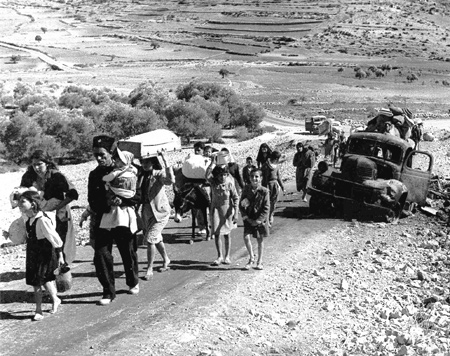 |
Palestinians driven from their homes in Galilee are on the road to Lebanon, November 1948. |
 How many times have you had a discussion about the plight of the Palestinians with supporters of the state of Israel and met the argument that the problem is the Palestinian “intolerance” of Jewish settlers? People have been taught that Israel was established as the result of a heroic fight for their homeland up against an “inhuman” enemy. But the reality is far different.
How many times have you had a discussion about the plight of the Palestinians with supporters of the state of Israel and met the argument that the problem is the Palestinian “intolerance” of Jewish settlers? People have been taught that Israel was established as the result of a heroic fight for their homeland up against an “inhuman” enemy. But the reality is far different.
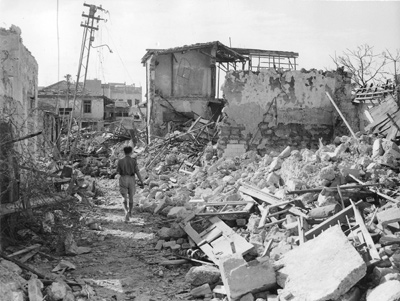 |
The Manshiah quarter in Jaffa, home to Palestinians, after it was destroyed by Irgun Jewish forces, May 1948. |
![]() In the early 1900s most of the world’s Jews lived in Europe, where they were bitterly oppressed and often very active in revolutionary and progressive movements. The Zionist movement arose in opposition to that. One of its founders, Herzl, said: “For Europe we shall create there in Palestine an outpost against Asia, we shall be the vanguard of the civilized world against barbarism.”
In the early 1900s most of the world’s Jews lived in Europe, where they were bitterly oppressed and often very active in revolutionary and progressive movements. The Zionist movement arose in opposition to that. One of its founders, Herzl, said: “For Europe we shall create there in Palestine an outpost against Asia, we shall be the vanguard of the civilized world against barbarism.”
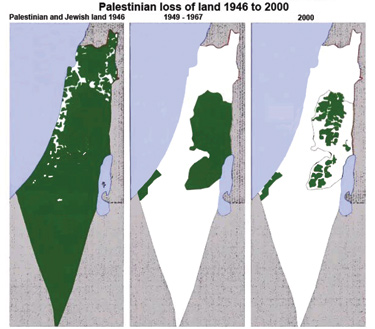 |
The Theft of Palestinian Land: (Palestinian Land is the green area) |
![]() At the end of World War 1, in 1918, there were 680,000 Palestinians and 56,000 Jews living in Palestine, and Palestinians owned 97 percent of the land. But in 1947, the UN gave the Zionist settler-colonialists 56 percent of Palestine. Even before the formal establishment of the state of Israel in 1948, these settler-colonialists began to aggressively expand their territory through a campaign of terror to expel Palestinians from their land.
At the end of World War 1, in 1918, there were 680,000 Palestinians and 56,000 Jews living in Palestine, and Palestinians owned 97 percent of the land. But in 1947, the UN gave the Zionist settler-colonialists 56 percent of Palestine. Even before the formal establishment of the state of Israel in 1948, these settler-colonialists began to aggressively expand their territory through a campaign of terror to expel Palestinians from their land.
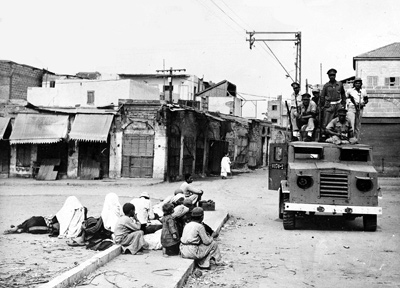 |
Palestinian residents watch Israeli occupation forces entering the town of Majdal, November 1948. |
![]() Palestinians call what happened to them from 1947 to 1948 the Nakba—Arabic for catastrophe. During the Nakba, almost a million Palestinians were brutally forced from their land, villages and homes, fleeing with only the possessions they could carry. Many were raped, tortured and killed. To ensure that there would be nothing for the Palestinians to return to, and to wipe out physical evidence that the land belonged to Palestinians, their villages and olive and orange trees were thoroughly razed. By the time the Nakba ended, there were 31 documented massacres, and probably many others. Over 530 Palestinian villages and 11 urban neighborhoods were emptied of their inhabitants.
Palestinians call what happened to them from 1947 to 1948 the Nakba—Arabic for catastrophe. During the Nakba, almost a million Palestinians were brutally forced from their land, villages and homes, fleeing with only the possessions they could carry. Many were raped, tortured and killed. To ensure that there would be nothing for the Palestinians to return to, and to wipe out physical evidence that the land belonged to Palestinians, their villages and olive and orange trees were thoroughly razed. By the time the Nakba ended, there were 31 documented massacres, and probably many others. Over 530 Palestinian villages and 11 urban neighborhoods were emptied of their inhabitants.
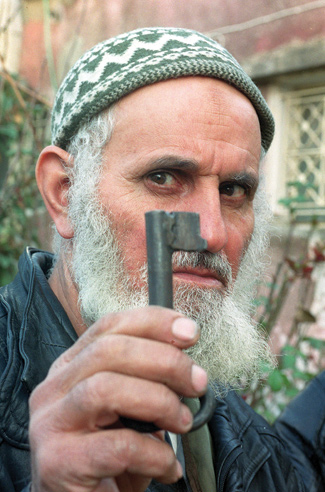 |
This 67-year-old Palestinian, now in the Dehaishe Refugee Camp, holds the original key to his family home in Deir Aban that they were forced to flee during Israeli occupation in 1948. |
![]() One infamous massacre took place in April 1948 at Deir Yassin, west of Jerusalem, where 250 people were murdered. Israeli historian Ilan Pappe (author of the book The Ethnic Cleansing of Palestine) describes how Jewish soldiers burst into the village and sprayed the houses with machine-gun fire, killing many instantly: “The remaining villagers were then gathered in one place and murdered in cold-blood, their bodies abused while a number of women were raped and killed.”
One infamous massacre took place in April 1948 at Deir Yassin, west of Jerusalem, where 250 people were murdered. Israeli historian Ilan Pappe (author of the book The Ethnic Cleansing of Palestine) describes how Jewish soldiers burst into the village and sprayed the houses with machine-gun fire, killing many instantly: “The remaining villagers were then gathered in one place and murdered in cold-blood, their bodies abused while a number of women were raped and killed.”
![]() As a result of the Nakba, there are now almost 4.5 million Palestinians dispersed throughout the world—in addition to the 1.4 million under Israeli military occupation in the West Bank and 1.3 million in Gaza. About 1.5 million Palestinians still live in Israel itself as second-class citizens. The state of Israel now occupies about 78% of historic Palestine, and the Israeli settlements in the West Bank continue to grow. Israel has no parallel in the world—a state consciously built, since its inception, for one people, one culture, on religious grounds and with no real permanent borders.
As a result of the Nakba, there are now almost 4.5 million Palestinians dispersed throughout the world—in addition to the 1.4 million under Israeli military occupation in the West Bank and 1.3 million in Gaza. About 1.5 million Palestinians still live in Israel itself as second-class citizens. The state of Israel now occupies about 78% of historic Palestine, and the Israeli settlements in the West Bank continue to grow. Israel has no parallel in the world—a state consciously built, since its inception, for one people, one culture, on religious grounds and with no real permanent borders.
The state of Israel was established through the ethnic cleansing of the Palestinian people. And since then Israel has played a central role as a bastion of American imperialist interests in the Middle East. Without U.S. military and political backing and massive financial aid ($3 billion a year in U.S. government aid, along with officially encouraged private funding), Israel would not be what it is today—if it even existed at all.
If you like this article, subscribe, donate to and sustain Revolution newspaper.



